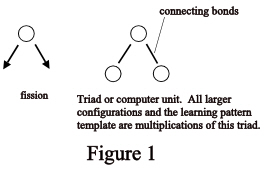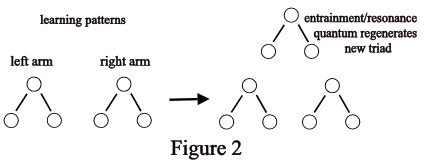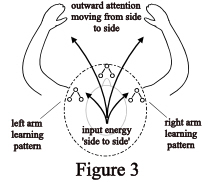THE MECHANICS OF COORDINATION
PART II
October, 2008
N.
Huntley, Ph.D.
In part I we discussed
mainly the template structure of the learning pattern. In part II there will be
a partial summary of Part I but, in particular, we shall focus on how the 'bits'
or units of the mind-computer system multiply. As explained
previously there are two basic processes in skill development: 1) improving the
ability to make individual movements (which manifests good reflexes), and 2) coordination
or linking together the individual movements.
In
both cases (1) and (2) above, the greater ability is due to increase in information
density or bits for storage of information, and in the case of (2) it is of course
also due to how many links are formed by repetition of specific movements (as
explained in Part I). Individual movements improve due to coordination of smaller,
less complex regions of bits. For example, the ability to make a motion of a limb
back and forth about a joint involves coordination of appropriate bits (there
is coordination of countless regions within each simple movement). However, because
these movements are simple, that is, anyone can make them, even before learning
a special skill, they don't appear to need improving, and one then only concentrates
on complex coordination (a mistake). Further, since the more complex coordination
requires so much attention and effort (involving trying to be accurate and applying
more than enough tension in the muscles), these learning patterns can become habit
patterns, preventing or hindering further change or expansion of the learning
patterns. By returning to simple basic movements the habit pattern can be broken
down and, further, the information density in the learning pattern for these simple
motions increased. How does this increase occur?
 Figure
1 illustrates this increase by fission. An electromagnetic unit (computer bit)
is encourages to 'divide' into two identical units. This is very simple compared
with cell reproduction, except that the electromagnetic (EM) unit retains its
former state and we have the 'triad'. This is normal for fundamental particles
that are not split by force. For example, the particle and its antiparticle
would originally have formed from a single unity, extending into two mirror-image
opposite particles but retaining its original single state in a higher region
of the frequency spectrum (the next dimensional stratum
or fractal level).
Figure
1 illustrates this increase by fission. An electromagnetic unit (computer bit)
is encourages to 'divide' into two identical units. This is very simple compared
with cell reproduction, except that the electromagnetic (EM) unit retains its
former state and we have the 'triad'. This is normal for fundamental particles
that are not split by force. For example, the particle and its antiparticle
would originally have formed from a single unity, extending into two mirror-image
opposite particles but retaining its original single state in a higher region
of the frequency spectrum (the next dimensional stratum
or fractal level).
 Thus
when in fact a particle and its separate antiparticle come together, they do not
disappear in a flash of energy, as stated in current science; they return to the
unity condition, merging with the next 'upper' fractal level (not detectable in
3D by scientific methodology).
Thus
when in fact a particle and its separate antiparticle come together, they do not
disappear in a flash of energy, as stated in current science; they return to the
unity condition, merging with the next 'upper' fractal level (not detectable in
3D by scientific methodology).
How does
one bring about this multiplicity of these EM units that increases the information
capacity of the learning pattern? Specific exercises for this are given in the
author's book The Attainment of Superior Physical Abilities. The EM units
are encouraged to divide, undergo fission, during relaxation cycles of the muscles.
A particular amount of tension is required at any one time for achieving certain
movements. Moments of relaxation reducing the tension in the muscle to below the
threshold level for the movement, but not sufficiently reduced in intensity and
time to stop the movement, will encourage (like leaving a gap to be filled) the
learning pattern to multiply the units to achieve the missing action. There is
a precise relationship between reducing tensions (increasing relaxation in higher
skills) and increasing holographic amplification and expansion of learning patterns,
that is, increase in information density in learning patterns per unit movement
(maths given in appendix of the above book).
Now
how does information capacity increase by fusion---meaning linking them together?
See Figure 2. For the average person, everyone has countless EM units in resonance
forming larger groups in ordinary movements---all these are learned movements:
walking, using a knife and fork, brushing teeth, reaching for an object, etc.
When we learn new movement combinations we are linking together learned single
or less complex movements to form new combinations of complexity---small learning
patterns are coupled  to
create larger ones.
to
create larger ones.
Let us take an example
of learning to coordinate one arm motion with the other arm motion. Envisage a
complex learning pattern operating one arm---equivalent to a subcomputer controlling
this arm---and similarly another learning pattern or subcomputer operating the
other arm. To coordinate the right and left arms they must be linked together,
cross-referenced or what we call coordinated. See Figure 3 which shows the learning
patterns for each arm. The attention, going back and forth from one arm to the
other, is the outward manifestation of the input in the mind, which is also moving
back and forth from one learning pattern to the other. The input is an energy
awareness unit which has a spectrum of frequencies (mainly scalar waves). As the
input energy oscillates from one side to the other it is entraining the oscillations
with the learning patterns matching one learning pattern with the other to bring
them into resonance. This quantum regenerates new bits or energy units each time
one bit on one side resonates with one bit on the other side. A learning pattern
now builds up which is central to the left and right learning patterns which will
operate them both simultaneously by a singular control of the input/attention.
Thus again we have the triad configuration---a built-up one---see Figure 3.
Clearly
this is not a typical 'fusion' of particles. The entrainment of frequencies unites
the energies and 'fuses' them into a new state as the 'central' learning pattern
is formed but something extra is added. This is a form of quantum regeneration---see
article in new education section on quantum regeneration---which is a general
principle of physics; the opposite of quantum reduction.
Return
to Home Page
 Figure
1 illustrates this increase by fission. An electromagnetic unit (computer bit)
is encourages to 'divide' into two identical units. This is very simple compared
with cell reproduction, except that the electromagnetic (EM) unit retains its
former state and we have the 'triad'. This is normal for fundamental particles
that are not split by force. For example, the particle and its antiparticle
would originally have formed from a single unity, extending into two mirror-image
opposite particles but retaining its original single state in a higher region
of the frequency spectrum (the next dimensional stratum
or fractal level).
Figure
1 illustrates this increase by fission. An electromagnetic unit (computer bit)
is encourages to 'divide' into two identical units. This is very simple compared
with cell reproduction, except that the electromagnetic (EM) unit retains its
former state and we have the 'triad'. This is normal for fundamental particles
that are not split by force. For example, the particle and its antiparticle
would originally have formed from a single unity, extending into two mirror-image
opposite particles but retaining its original single state in a higher region
of the frequency spectrum (the next dimensional stratum
or fractal level). Thus
when in fact a particle and its separate antiparticle come together, they do not
disappear in a flash of energy, as stated in current science; they return to the
unity condition, merging with the next 'upper' fractal level (not detectable in
3D by scientific methodology).
Thus
when in fact a particle and its separate antiparticle come together, they do not
disappear in a flash of energy, as stated in current science; they return to the
unity condition, merging with the next 'upper' fractal level (not detectable in
3D by scientific methodology). to
create larger ones.
to
create larger ones.